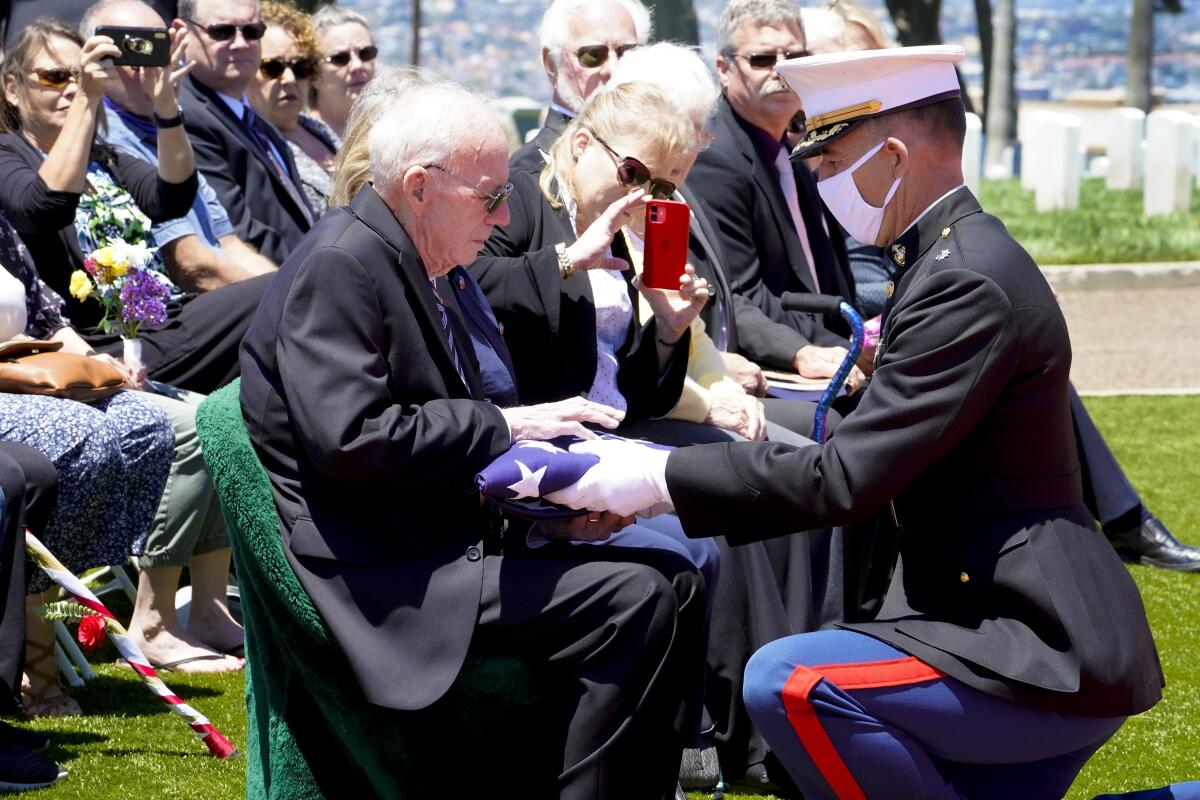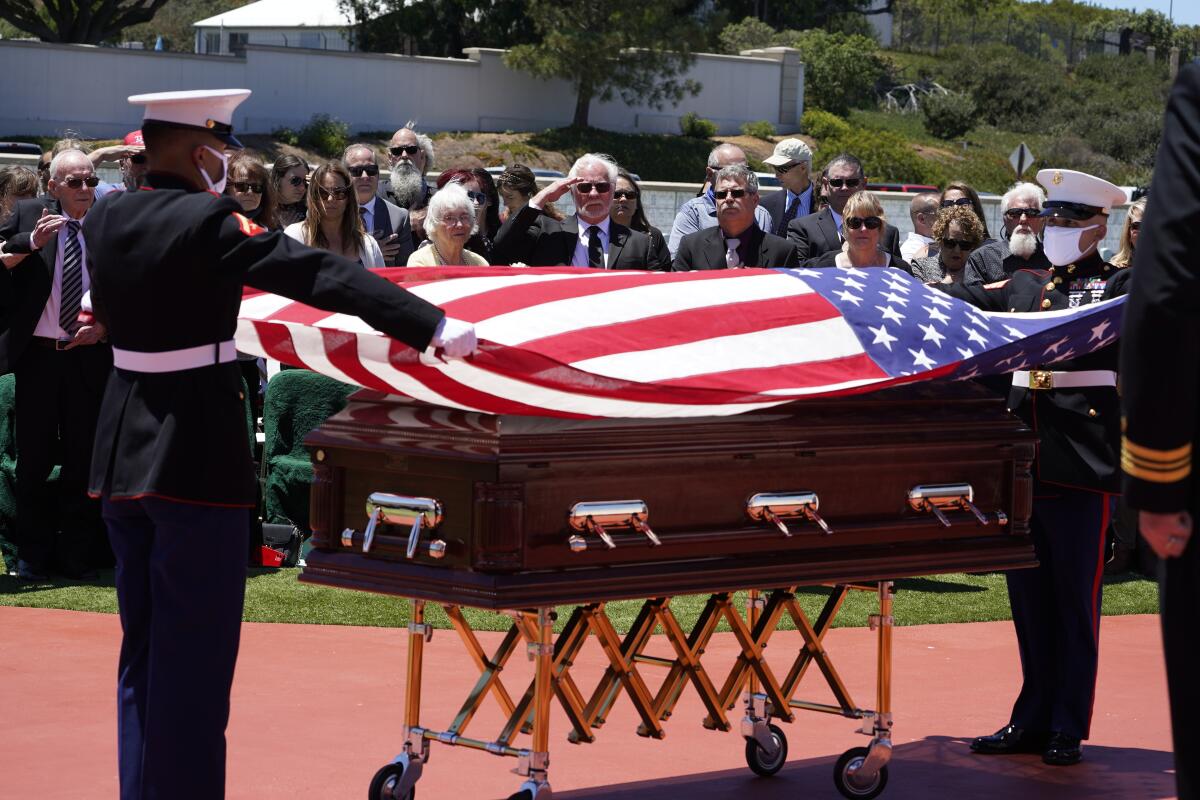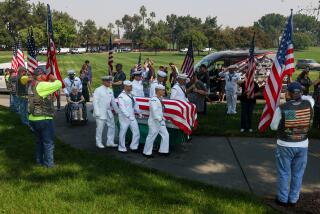80 years after Pearl Harbor, a family’s uncertainty ends as a Marine is laid to rest

- Share via
SAN DIEGO — A promise the military makes to its fighting forces — no person left behind — was kept this week at Fort Rosecrans National Cemetery, where the long-unidentified remains of a San Diego Marine were buried almost 80 years after he died in the attack on Pearl Harbor.
Pfc. John Franklin Middleswart, 19 when he was killed aboard the battleship Oklahoma, was laid to rest with full military honors in a ceremony attended by about 50 people.
“Dec. 7, 1941, was a long time ago,” Navy Chaplain Robert LeCompte told the group. “What an amazing miracle it is to have John with us today.”
The miracle came about through mitochondrial DNA, extracted from Middleswart’s bones and compared with DNA from his sister and two of his nephews. The family was notified of the match earlier this year.
“It’s the end of a journey,” said James Brown, 80, one of the nephews. “We couldn’t be happier.”
Middleswart was among 415 sailors and 14 Marines unaccounted for after Japanese torpedoes sunk the Oklahoma in the devastating surprise attack on Pearl Harbor that led the United States into World War II.
Hundreds of bodies were recovered from the ship during salvage operations after the attack, but their identifies could not always be determined. The remains were buried as “unknowns” in two cemeteries in Hawaii.
After the war, the U.S. launched a worldwide effort to repatriate the dead. The remains from the Oklahoma were exhumed and sent to a laboratory at Scofield Barracks on Oahu. Investigators there were able to identify 35 of the service members.
That left 394 men unaccounted for. In 1950, seeing no way to identify them — DNA technology and other forensic advances had not happened — officials commingled the bones in 62 caskets and buried them again, this time at the National Memorial Cemetery of the Pacific in Honolulu.
And there they rested, for more than 50 years.

In San Diego, Middleswart’s absence became a presence, inspiring family members through his sacrifice. His sister, Lauretta Brown, named one of her sons after him. Two of her other children, James Brown and Edward Brown, joined the Marines because of their uncle.
Officially, Middleswart was listed as missing and presumed dead, his remains “nonrecoverable.” His parents were sent an American flag and a Purple Heart to honor him.
But not having a grave with his name on it, not having a place to mourn him, weighed on them the rest of their lives, family members said.
“We were always hoping one day they would identify him and bring him home,” James Brown said.
In 2003, one of the caskets from the Oklahoma was disinterred so that new identification techniques could be tried. They worked: Remains of six people were matched with names.
That launched a larger project. The families of the missing were asked to provide DNA samples. Middleswart’s sister and two nephews gave theirs in 2009.
In 2015, the remaining Oklahoma caskets were dug up and sent to a laboratory at Offutt Air Force Base in Nebraska. Investigators there began sifting through about 13,000 skeletal pieces. They extracted DNA, pored over dental records, and examined chest X-rays taken when service members enlisted.
In February, Middleswart’s family was notified of a match, the 300th from the Oklahoma remains. They received a thick notebook from the lab showing them the evidence used to make the identification.
“The amount of work they did was amazing,” James Brown said. “Anyone who wears the uniform should take comfort in the fact that they will never be forgotten or forsaken.”
This week’s ceremony under blue skies brought more smiles than tears from the attendees. That was a reflection of how much time has passed, and of the relief they felt at finally having resolution. What had been a question mark became a period.
“This means the world to us,” Edward Brown said.
As the oldest relative at 85, he was given the flag that had draped his uncle’s casket, a time-honored conclusion to military funerals. Two Marines in dress blues folded it into a triangle, then Lt. Col. Christopher Benson presented it to Brown on bended knee, “on behalf of a grateful nation.”
Earlier, seven other Marines, also in dress blues, fired a three-volley rifle salute. Another sounded taps on a bugle.
After the ceremony, in a nod to Pearl Harbor, Middleswart’s great-nephew Phil Brown placed a lei on the casket. Middleswart’s niece Nancy Flahive kissed her hand and touched the casket. Other relatives came up to pay their respects and have their pictures taken.
If there was a down note, family members said, it was this: Lauretta Brown, Middleswart’s sister, died several years ago, before an identification could be made.
“My mother was really hoping it would happen while she was still with us,” James Brown said.
She died knowing that he was remembered, though. In 2010, she went to the Honolulu cemetery where the remains of the Oklhoma’s dead were buried and saw her brother’s name memorialized in stone, etched on a wall with those of others still lost from the nation’s various wars.
Soon his name will have a rosette next to it, an appendage with a particular meaning. It signals that he is no longer missing, an end to a long journey home.
Wilkens writes for the San Diego Union-Tribune.
More to Read
Sign up for Essential California
The most important California stories and recommendations in your inbox every morning.
You may occasionally receive promotional content from the Los Angeles Times.











